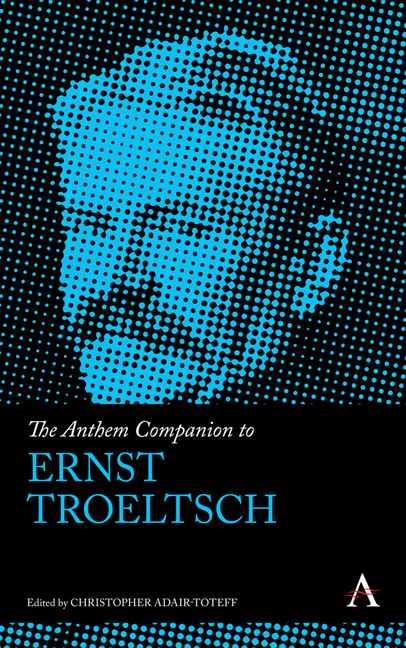Book contents
- Frontmatter
- Contents
- Introduction Ernst Troeltsch: Theologian, Sociologist, Philosopher, and Culture Critic
- Chapter One The Independence of Religious Phenomena: The Work of Ernst Troeltsch as a Template for the Study of Religion
- Chapter Two Troeltsch on Protestantism and Modernity
- Chapter Three Church, Sect, Mysticism: Writing the History of Christianity
- Chapter Four Troeltsch's Personalism
- Chapter Five Performative Practice: Ernst Troeltsch's Concept(s) of Christianity
- Chapter Six Troeltsch and the Problem of Theological Normativity
- Chapter Seven Troeltsch as Dogmatic Theologian
- Chapter Eight Ernst Troeltsch and the Problem of Historicism
- List of Contributors
- Index
Chapter Five - Performative Practice: Ernst Troeltsch's Concept(s) of Christianity
Published online by Cambridge University Press: 10 May 2018
- Frontmatter
- Contents
- Introduction Ernst Troeltsch: Theologian, Sociologist, Philosopher, and Culture Critic
- Chapter One The Independence of Religious Phenomena: The Work of Ernst Troeltsch as a Template for the Study of Religion
- Chapter Two Troeltsch on Protestantism and Modernity
- Chapter Three Church, Sect, Mysticism: Writing the History of Christianity
- Chapter Four Troeltsch's Personalism
- Chapter Five Performative Practice: Ernst Troeltsch's Concept(s) of Christianity
- Chapter Six Troeltsch and the Problem of Theological Normativity
- Chapter Seven Troeltsch as Dogmatic Theologian
- Chapter Eight Ernst Troeltsch and the Problem of Historicism
- List of Contributors
- Index
Summary
What is Christianity? Trained as a theologian, Ernst Troeltsch (1865– 1923) combined the theological and the nontheological disciplines of the humanities in order to identify Christianity. It is perplexing that a theologian who knew as much about Christianity as Troeltsch, would not or could not take the identity of Christianity for granted. He stressed that identity is not a fixed freeze- frame that would allow scholars definitely to decide what counts as Christian and what counts as non- Christian. Instead, for Troeltsch, identity itself is in motion. “But what, then, is Christianity?”
In the reception of Troeltsch's interdisciplinary thinking, his conceptualization(s) of Christianity have caused frustration and fascination alike. These conceptualizations were constructed through a combination of sociological and theological accounts of Christianity's history. Troeltsch condensed them in the seminal study “What Does ‘Essence of Christianity’ Mean?,” published in 1903 and republished in 1913. Here, he aims to ask and to answer how a scholar might arrive at the identity of Christianity. But, again, he offers no clear- cut answers. Both defenders and despisers of Troeltsch who have examined his study conclude that it is “so muddled”— a conclusion that, wittingly or unwittingly, confirms Karl Barth's assessment of Troeltsch's thinking as “the proclamation and ever renewed proclamation of programs” that never arrive at any result. Yet interpretations that mock Troeltsch as “muddled” because he fails to draw a definite distinction between what is essentially Christian and what is essentially non- Christian assume that Troeltsch aimed to arrive at such a distinction. Countering these assumptions, I argue that Troeltsch advocates a hermeneutics of identification that resists any conceptual closure of Christianity. Through his hermeneutics, Troeltsch anticipated the theorizations of identity so characteristic of modern and postmodern thought that turn identity into a task, because he defined identity not by what it describes but by what it does. Hence, Troeltsch's concept of Christianity, I argue, could be conceived of as performative practice.
Admittedly, Troeltsch rejected hermeneutics as a romanticism that requires the sympathetic skill set of a “genius” to succeed. But given that he has been labeled a “liberal,” even though he criticized philosophical and theological liberalism, it might be promising to relabel Troeltsch as a hermeneut, even though he criticized philosophical and theological hermeneutics. In his autobiographical account, “My Books,” published in 1922, he announced, “I have no system.”
- Type
- Chapter
- Information
- The Anthem Companion to Ernst Troeltsch , pp. 83 - 104Publisher: Anthem PressPrint publication year: 2017



